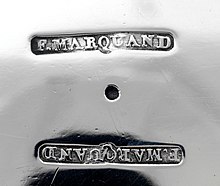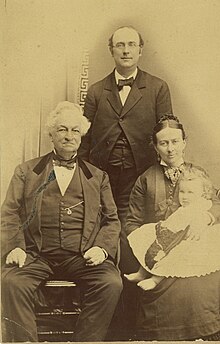Draft:Marquand and Co.
 | Review waiting, please be patient.
This may take 3 months or more, since drafts are reviewed in no specific order. There are 2,542 pending submissions waiting for review.
Where to get help
How to improve a draft
You can also browse Wikipedia:Featured articles and Wikipedia:Good articles to find examples of Wikipedia's best writing on topics similar to your proposed article. Improving your odds of a speedy review To improve your odds of a faster review, tag your draft with relevant WikiProject tags using the button below. This will let reviewers know a new draft has been submitted in their area of interest. For instance, if you wrote about a female astronomer, you would want to add the Biography, Astronomy, and Women scientists tags. Editor resources
Reviewer tools
|
| Submission declined on 30 September 2023 by Suitskvarts (talk). This draft's references do not show that the subject qualifies for a Wikipedia article. In summary, the draft needs multiple published sources that are:
The proposed article does not have sufficient content to require an article of its own, but it could be merged into the existing article at Black, Starr & Frost. Since anyone can edit Wikipedia, you are welcome to add that information yourself. Thank you.
Where to get help
How to improve a draft
You can also browse Wikipedia:Featured articles and Wikipedia:Good articles to find examples of Wikipedia's best writing on topics similar to your proposed article. Improving your odds of a speedy review To improve your odds of a faster review, tag your draft with relevant WikiProject tags using the button below. This will let reviewers know a new draft has been submitted in their area of interest. For instance, if you wrote about a female astronomer, you would want to add the Biography, Astronomy, and Women scientists tags. Editor resources
This draft has been resubmitted and is currently awaiting re-review. |  |
 Comment: See also WP:COI. Suitskvarts (talk) 20:00, 30 September 2023 (UTC)
Comment: See also WP:COI. Suitskvarts (talk) 20:00, 30 September 2023 (UTC)
 | |
| Founded | 1804, New York City & Savannah, Georgia |
|---|---|
| Founder | Isaac Marquand |
| Defunct | 1838 |
| Fate | Sold to William Black and Henry Ball, becoming Black, Ball, and Co. |
| Successor | Black, Starr & Frost |
| Headquarters | |
Key people | Henry Gurdon Marquand, Frederick Marquand, Isaac Marquand |
| Products | tea services; tongs; pitchers; trays; gravy boats |
History:
Marquand and Company was founded in 1804 by Connecticut silversmith Isaac Marquand. Over the course of several years, the company grew and prospered significantly. In 1810, the company was headquartered in New York City, near Maiden Lane.[1] In 1820, Isaac's son Frederick moved to Savannah, Georgia with his cousin, Josiah Penfield, to open their own silversmith trade. However, the two left Savannah in 1824, with Frederick taking over the flourishing Marquand and Co. from his father. The company was headquartered at 166 Broadway, and overtime became regarded as "the principal jewelers in the country," as stated in the obituary of Tiffany and Co. secretary Edward C. Moore.[2]

Throughout their history, Marquand and Co. created a vast array of silver products, including "helmet" shaped gravy boats from 1833-39, as well as intricate full-service tea sets.[3][4] Frederick, according to a contemporaneous article in the New York Times, was "the most prominent jeweler in the city."[5] Many of their pieces are currently held in the collections of the Metropolitan Museum of Art.[6]
Henry Marquand, an original trustee of the Metropolitan Museum of Art, briefly worked for the company before working on Wall Street in investment banking. Henry served as the second President of the Metropolitan Museum, where to this day his bequest of Old Master paintings is a central piece of the collection.[7]
Marquand and Company served as a prototype for American-made silver products, paving the way for present-day success stories such as Tiffany and Co.[8] For instance, as the United States economy began to transform in the nineteenth century, Marquand and Co. was the top silver making firm available for costly commissions from business titans. Marquand silver was treated as a status symbol, and entered the art collections of numerous affluent collectors, such as that of Alphonso T. Clearwater.[9]
In 1832, Frederick Marquand completed a commission for a gold medal, commemorating the role of a volunteer honor guard of George Washington's during the Revolutionary War. The medal contains miniature portraits of Washington and the Marquis Lafayette. It also contains the words "N. America" and "France." While James Fenimore Cooper was serving as the American consul in Paris, he presented this object to Lafayette. It is now in the collections of the Winterthur Museum.[10]
Frederick Marquand, aside from creating his own pieces, also promoted and sold work from other renowned artists. For instance, William Forbes, a renowned artist, designed numerous pieces that were later sold by Marquand and Co.[11] John C. Moore, renowned for his famous tea sets, also worked predominately with Marquand and Co. before he entered an exclusive deal with Charles Tiffany.[12]
Frederick Marquand, after serving at the President of Marquand and Company, sold the business in 1838 to former apprentices William Black and Henry Ball.[3] The firm soon took the name Black, Ball, and Co.[3] Frederick took the proceeds from the sale of his business, and invested it in New York City real estate, as well as other financial ventures.[13]
Collections:

Many of these pieces ended up in Gilded Age mansions throughout the East Coast. Henry Gurdon Marquand, having grown wealthy, built his own mansion, "Linden Gate,"[14] in Newport. Constructed by Richard Morris Hunt in 1872, architecturally, it drew comparisons to Chateau sue Mer.[15] When the contents of Chateau sue Mer were auctioned off by Christie's, pieces of Marquand silver were in the collection.

Long after the company had been absorbed, original Marquand silver still maintained it's collectability. Renowned curator and collector Sam Wagstaff had numerous pieces of Marquand and Co. silver in his personal collection. The partner of Robert Mapplethorpe, after his death, the New-York Historical Society held an exhibition of his silver collection.[16] Many of these pieces have migrated to the permanent collection of the Metropolitan Museum of Art. The Winterthur Museum, founded by Henry Francis DuPont, also contains a vast collection of Frederick Marquand's silver, as well as the Museum of the City of New York.[17][18]
Boston's Museum of Fine Art maintains a rare silver spoon made by Frederick Marquand, dated 1830. It's description reads: "Fiddle-shaped, wheat sheaf stem with curved shoulders, downturned end and shell drop at back joint; egg-shaped bowl."[19] This highlights the intricacy innate in Marquand Silver, as this spoon is relatively mundane in comparison to the larger commissions the firm completed during this period. Yale University's Art Gallery maintains many pieces of more intricate Marquand and Co. silver, including very examples of clockmaking.[20] While the Marquands mainly worked in New York City and Connecticut, the bulk of collections containing Marquand silver are located in the northeast. However, owing to Frederick's early start in Savannah, Georgia, there are quite a few southern museums with vast collections. For instance, the Georgia Museum of Art has an incredibly intricate pitcher designed by Frederick with biblical scenes of the "Good Samaritan."[21] Savannah's Telfair Museum also contains several unique pieces, including an incredibly detailed water pitcher.[22]
Gallery:
-
Commemorative medal made by Frederick Marquand (1832). Collection of Winterthur Museum.
-
Marquand and Co. Pair of Antique Coin Silver Gravy Boats, NYC, NY, (1833-39). Possibly the design work of John C. Moore.[23]
-
Silver tongs for a Marquand tea set (1834). Collection of Yale University Art Gallery.[24]
-
Frederick Marquand, "Pitcher with Scenes of the Good Samaritan," (1820-1830). Collection of the Georgia Museum of Art.
References
- ^ "Bonhams : A pair of American coin silver ewers (Probably Wm. Forbes, New York, NY), circa 1835, retailed by Frederick Marquand". www.bonhams.com. Retrieved 2024-03-01.
- ^ "Secretary Edward C. Moore, of Tiffany & Co., Expires". The Jeweler's Circular and Horological Review: 31. August 5, 1891.
- ^ a b c "Marquand and Co. Pair of Antique Coin Silver Gravy Boats, NYC, NY, 1833-39". Retrieved 2023-09-11.
- ^ "Edlred's Auction House". Retrieved 2023-09-11.
- ^ "FREDERICK MARQUAND'S WILL". The New York Times. 1882-09-23. ISSN 0362-4331. Retrieved 2023-09-12.
- ^ "Metropolitan Museum of Art". Retrieved 2023-09-11.
- ^ "Finding Aid for the Henry Gurdon Marquand papers" (PDF). Retrieved 2023-09-11.
- ^ "Bonhams : A pair of American coin silver ewers (Probably Wm. Forbes, New York, NY), circa 1835, retailed by Frederick Marquand". www.bonhams.com. Retrieved 2024-03-01.
- ^ "Frederick Marquand | Sauceboat | American". The Metropolitan Museum of Art. Retrieved 2024-03-01.
- ^ "Metals - Medal (Presentation medal) - Search the Collection - Winterthur Museum". museumcollection.winterthur.org. Retrieved 2024-03-06.
- ^ Ltd, Spencer Marks. "Marquand and Co. Pair of Antique Coin Silver Gravy Boats, NYC, NY, 1833-39". Spencer Marks Ltd. Retrieved 2024-03-07.
- ^ Ltd, Spencer Marks. "Marquand and Co. Pair of Antique Coin Silver Gravy Boats, NYC, NY, 1833-39". Spencer Marks Ltd. Retrieved 2024-03-07.
- ^ Del Collo, Adrianna (4 March 2024). Henry Gurdon Marquand Papers, 1852–1903. Metropolitan Museum of Art.
- ^ "Linden Gate Mansion (Henry G. Marquand House), Newport Rhode Island". Historic Structures. Retrieved 2024-03-01.
- ^ "Linden Gate Mansion (Henry G. Marquand House), Newport Rhode Island". Historic Structures. Retrieved 2024-03-01.
- ^ Glueck, Grace (1987-01-16). "SAM WAGSTAFF, 65, A CURATOR AND PHOTOGRAPHY COLLECTOR". The New York Times. ISSN 0362-4331. Retrieved 2024-03-01.
- ^ "Metals - Spoon - Search the Collection - Winterthur Museum". museumcollection.winterthur.org. Retrieved 2024-03-06.
- ^ "MCNY Collections Portal". collections.mcny.org. Retrieved 2024-03-07.
- ^ "Dessert spoon". collections.mfa.org. Retrieved 2024-03-07.
- ^ "Tall Case Clock | Yale University Art Gallery". artgallery.yale.edu. Retrieved 2024-03-07.
- ^ "Search marquand (Objects) – Search – eMuseum". emuseum.georgiamuseum.org. Retrieved 2024-03-07.
- ^ "Water Pitcher". collections.telfair.org. Retrieved 2024-03-07.
- ^ Ltd, Spencer Marks. "Marquand and Co. Pair of Antique Coin Silver Gravy Boats, NYC, NY, 1833-39". Spencer Marks Ltd. Retrieved 2024-03-07.
- ^ "Sugar Tongs | Yale University Art Gallery". artgallery.yale.edu. Retrieved 2024-03-07.
